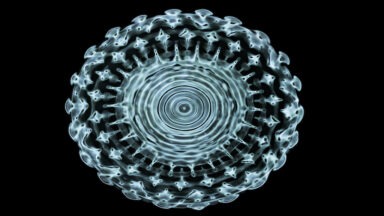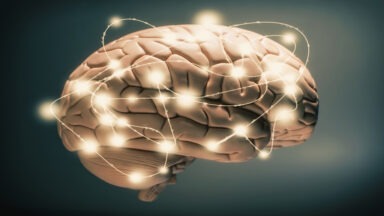God on the Brain; The God Helmet and How We Experience the Divine

For most people, the search for God leads to a mosque, an ashram, a synagogue, or a church. For others, they head to a mountaintop or a quiet, calm place seeking stillness and contemplation. But is it possible to experience God through a wearable apparatus or even a helmet, like one would wear biking or skiing? Can divine experience be artificially triggered in our brains? Inventor Stanley Koren and neuroscientist Michael Persinger, as well as those who have contributed to their work, would answer, yes, it is possible.
Stanley Koren was a neuroscientist who developed what is known as the God Helmet based on the specifications created by Persinger. The helmet is an experimental object designed to study religious experiences and creativity, all through a subtle temporal lobe stimulation that impacts the part of the brain usually associated with how we understand God — the amygdala and hippocampus. The God, or Koren Helmet, merges science and religion into a research field that is dedicated to investigating what role the brain plays in religious, mystical, and creative experiences.
The God Helmet; How Does It Work?
The Koren Helmet utilizes a network of low-intensity magnetic signals, or a field-to-field interaction onto the brain, mildly disrupting the brain which causes the left and the right side to communicate, specifically about a sensed, or religious presence. The experience of using the helmet highlights the brain’s central role to what is recognized as a deep spiritual embodiment, normally associated with activities such as prayer, fasting, or meditation. Sessions are held in the quiet of an acoustic chamber, or totally silent room with electromagnetic insulation.
For Persinger, the brain is considered to be the key to understand religion, including the physiological causes, as well as, ways to replicate or train the brain to deepen the divine experience. According to Persinger, who tested the God Helmet on more than 2,000 subjects, up to 80 percent state that the mild disruption that the God Helmet provides created a “sensed presence,” a feeling subjects, both those who identified as believers and non-believers, described as religious, or spiritual. Additionally, about one percent of subjects said they had direct experiences of God, though Persinger doesn’t consider these numbers accurate as such experiences can be quite personal and profound, often making it difficult for researchers to record.
The Growing Field of Brain Helmet Stimulation: Science and Spirituality Merge
The God Helmet is part of a rich field of growing research in the field of brain stimulation that includes and extends beyond the medical field, including the TMS helmet, and more recently, the Neuroelectric Wireless Helmet. The neuroelectric wireless brain helmet measures and stimulates neurons with the goal being to diagnose and treat certain illnesses including epilepsy, severe depression, post-stroke rehabilitation, as well as PTSD in veterans, fostering brain neuroplasticity.
Unlike the God helmet or the neuroelectric wireless brain helmet, transcranial magnetic stimulation, or TMS, utilizes electronic currents in a noninvasive manner and is emitted from a magnetic coil that is attached to the scalp. Approved by the FDA, the TMS helmet applies varying levels of electronic charges which enter the brain waves themselves, with therapeutic results with neurological disorders and in mental health, most beneficially with those who suffer from severe depression. Yale University is among a number of medical teaching institutions that take the TMS helmet’s capacity to heal severe depression seriously, along with Johns Hopkins University.

The 64 coil Shiva heasdset
Beyond the brain helmets or apparatus that are medically-focused, there are a number of other helmet therapies including the Experience Helmet. Created by Aiste Noreikaite, a London designer, the helmet transmits someone’s brain activity through a NeuroSky EEG, which then gets translated back into a programming language that plays meditative electronic sounds created by that person’s brain, resulting in a calm and contemplative state.
Also created by one of Dr. Persinger’s students, the eight-channel Shiva Neural Stimulation system, which can be set up as the God Helmet as a version of Persinger’s “Octopus,” and a simplified, two-channel apparatus that foregoes rotatino over the temporal lobes, known as the Shakti system.
These technologies represent a new generation designed to induce and awaken psychic perceptions, develop spiritual awareness, and is designed to heal anxiety, fear, depression, and anger.
Instead of a solid helmet, these systems are open-sided and circle the brain with a rapid magnetic signal at various rotations per second. The magnetic stimulation interacts with the cortical segment of the brain in the right hemisphere, the non-verbal thinking part of the brain. Users of this technology claim higher levels of spiritual awareness, psychic insights, or other more intuitive powers.
Sacred Neurology or Suggestibility?
As with anything having to do with religion, the God helmet has plenty of skeptics, including biologists and the famously intractable materialist/atheist Richard Dawkins, who volunteered to test the machine in 2003. “I’ve always been curious to know what it would be like to have a mystical experience,” Dawkins said prior to the experiment. However, despite Dawkins’ curiosity, he experienced only slight dizziness and a tingling sensation in his leg.
Though according to researchers administering the experiment on Dawkins, he had consumed alcohol prior to the test and imbibing interferes with the conditions necessary to properly entrain the brain. One wouldn’t expect to successfully induce a mystical experience through meditation while intoxicated, so why wouldn’t he have abstained before submitting himself to such a test?
Graham Hancock once pressed Dawkins on why he was averse to the use of psychedelics to induce the mystical state, to which he responded with receptivity before referencing his “failed” God Helmet experiment: you can listen to their interaction here.
But despite this well-publicized outcome, Persinger was not discouraged, stating that some people are simply more genetically disposed to the “sensed feeling” associated with God. Other criticisms of the God Helmet and accompanying research have included the suggestibility of the subjects, who were aware in advance how the God helmet worked, casting doubt on the authenticity of the research. Though this criticism has been disproven as Persinger does, in fact, conduct experiments using placebo-controlled, double-blind methodologies.
Dr. Persinger’s work is also not entirely focused on the mystical, but also clinically focused, as he has studied the effects of his helmets as modalities for treating various types of depression — both long-term and ephemeral types from concussions and head trauma.
The God Helmet: Proof of a ‘God’ Gene?
The God Helmet is part of a body of scientific research dedicated to exploring the existence of a “God” gene or a genetic component that shows a biologically driven religious tendency toward frequent prayer and a strongly felt presence of the divine. Persinger was inspired by research conducted in the 1950s by Wilder Penfield, who studied people with epilepsy. During surgery, Penfield electronically stimulated various parts of the brain and recorded the patients’ sensation which included hearing voices and seeing visions.
While not without critics, the God Helmet is responsible for a new understanding of the complexity that is our brain function, one that goes far beyond what we’ve previously imagined, as well as adding to the body of scientific research devoted to how the sacred exists in our biology. Could the sensed presence of God be developed, regardless of one’s religious beliefs, upbringing, or genetics, by simply slipping on a hard-cased helmet? The implications are many, but one of the most obvious ones is that the God Helmet could forever change our understanding and relationship to what we have thought of as a higher power.
Correction 11/19/2019: A previous version of this article omitted the fact that Richard Dawkins had consumed alcohol prior to submitting himself to a test using Dr. Persinger’s technology, marring the results of the experiment. Other clarifications regarding the results of Persinger’s work were also corrected.
The Pineal Gland’s Spiritual Connection With the Third Eye Chakra

The third eye is our greatest gift to connect us to source and remind us of a universe much more mystical than we can perceive with our physical senses. It’s through the awakening of the third eye and its corresponding pineal gland that we’re able to attain supernatural feats of telepathy, psychic vision, and an intimate connection with God.
Rare is a conversation on higher consciousness without a mention of the pineal gland. Its prevalence is more than a fad; it’s an imperative first step to attaining our full human potential.
What is the Pineal Gland?
The pineal gland, often referred to as the “third eye” in Eastern esoteric religions (Hinduism, Buddhism, and Taoism), is a pea-sized endocrine gland located deep in the center of the brain, between the two hemispheres. In Western medicine, it is an organ primarily recognized for its role in regulating the body’s circadian rhythms and melatonin production, which helps regulate sleep-wake cycles. The pineal gland also plays a part in the body’s response to light and darkness, influencing mood, energy levels, and overall well-being. While it holds significant physiological importance, some spiritual practices also attribute metaphysical qualities to the pineal gland, linking it to intuition, perception, and spiritual enlightenment.
The Pineal Gland and Third Eye Chakra
The chakra system is the way the spirit moves within the physical body—how the spirit animates form. The chakras can be imagined as wheels of energy to remain balanced and open for optimal human function. If stagnation appears within the chakra system, the physical body will be affected by unease, depression, and even illness.
Chakras are energy centers, whereas organs have defined locations. The chakras are ruled by the organs but are not confined to a specific location. The heart chakra, for instance, is in the center of the chest, while the physical heart is on the left side. Similarly, the third eye chakra is located in the center of the forehead near the pineal gland.
The pineal gland is known as the third eye chakra or ajna chakra in the Hindu system. A closed ajna (i.e. mind) is said to lead to confusion, uncertainty, cynicism, and pessimism.
Every esoteric tradition heralded the third eye as our connection to spirit. It’s the space between humans and God, moving us from the isolation experienced in the human condition—through an open and vibrant third eye, we find our highest source of ethereal energy. A return path to God is offered when one works to expand third-eye awareness.





































